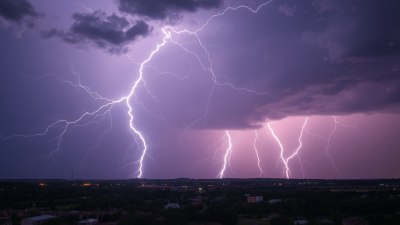Why Thunder Feels Like the Sky Arguing on Your Behalf
Explore why thunder sounds like the sky is arguing for you, with science and culture behind its booming presence.

Thunder is one of nature's most powerful and dramatic phenomena. To many, it isn’t just a startling noise; it feels like the sky itself is arguing fiercely on your behalf. This evocative image captures the deep emotional and cultural significance thunder has held across human history. But why does thunder produce such an overwhelming sensation, and why do people often perceive it as a vocal expression—almost an argument—from the heavens?
The Science Behind Thunder
Thunder is actually the sound caused by lightning. When a lightning bolt zips through the air, it heats the surrounding air to incredibly high temperatures—up to 30,000 Kelvin (53,540 degrees Fahrenheit). This sudden heating causes the air to expand rapidly, creating a shock wave that travels through the atmosphere and reaches our ears as thunder.
The noise of thunder varies depending on how far away the lightning strike is. Close strikes produce sharp, loud cracks, while distant strikes sound like low rumbles because the shock waves scatter and weaken over distance. This rumbling effect contributes to the feeling of “an argument” or a vigorous, ongoing conversation in the sky. The rolling sound triggers an imagined sense of dialogue or confrontation, making thunder feel like an active participant rather than a simple noise.
Why Thunder Feels Like an Argument
The sensation that thunder is arguing for you can be viewed from both psychological and cultural perspectives. Psychologically, thunder’s sudden, powerful, and unpredictable nature can evoke strong emotional responses. The booming sound breaks through ambient noise and commands attention, just like a person loudly asserting their viewpoint. Its complexity and irregular rhythms can mimic the intonations and cadences of heated speech.
Culturally, many societies have historically interpreted thunder as the voice of gods or spirits. These loud, resounding noises were often seen as celestial messages or expressions of divine anger or support. When thunder follows a storm, it might convey the sky’s displeasure with wrongdoing or injustice, metaphorically “arguing” on behalf of those who feel powerless. This idea makes thunder feel personal and protective—a form of natural advocacy.
Mythology and Thunder as Communication
Across cultures, thunder frequently appears as a means of divine communication. In Norse mythology, Thor wields his hammer Mjolnir to create thunder, symbolizing his role as a powerful protector of humanity. In many Native American traditions, thunder is associated with Thunderbird, a spiritual being whose wing beats generate thunderclaps as signs of strength and presence.
These mythological figures embody the idea of thunder as an assertive force standing up for people, defending order, or punishing wrongs. This narrative enhances the impression that thunder is an argument pitched by the sky itself—fierce, formidable, and unyielding.
Thunder’s Effect on Human Emotions
The physical impact of thunder also influences how people interpret it emotionally. Thunder’s sudden loudness triggers a natural startle reflex, but its prolonged rumbling can also induce feelings of awe and connection to nature. In some, the sound of thunder invokes a primal sense of protection because it signals the presence of a powerful force beyond human control.
When people feel overwhelmed or silenced in daily life, thunder’s seemingly defiant roar echoes their inner frustrations. It simulates a scenario where the sky itself is rising up in vocal support, making the phenomenon feel both cathartic and empowering. This perception helps explain why many find thunder comforting despite its intensity.
Acoustic Qualities That Mimic Speech
Thunder’s varying intensity and rhythm often resemble the dynamics of human speech or argument. Its start-stop bursts and rolling crescendos can map onto the cadence of someone forcefully making a point and emphasizing key phrases. This auditory similarity fosters a subconscious association between thunder and human communication.
Moreover, cracks and booms intermixed with quieter intervals create a dynamic acoustic pattern reminiscent of a heated debate punctuated by moments of silence. Our brains are naturally wired to seek meaning and patterns, so these sound qualities encourage the idea of the sky “arguing” rather than simply making noise.
Thunder and the Human Need for Connection
Humans have a deep-rooted need to assign meaning to natural events, especially those that impact survival or evoke strong emotions. Thunder, with its dramatic presence, provides a canvas on which to project feelings and narratives. The notion that thunder argues on your behalf is one way people forge emotional connections with their environment.
By interpreting thunder as an ally in times of struggle—almost like an unseen advocate—people find comfort and solidarity. This psychological phenomenon helps individuals cope with fears or frustrations, shifting thunder from a mere weather event to a symbol of resistance and hope.
The Role of Thunder in Literature and Art
Thunder has long served as a powerful metaphor in literature and art, reinforcing its image as the sky voicing opinions or emotions loudly and clearly. Writers often use thunder to symbolize conflict, change, or divine intervention. It underscores critical moments by embodying tension or breakthroughs.
In paintings and films, thunder and lightning scenes visually and aurally heighten drama and signal pivotal plot shifts. These depictions cement the perception of thunder as an intentional expression with the weight of argument or protest etched into its powerful vibrations.
Scientific and Cultural Integration
The way science explains thunder complements cultural interpretations rather than replacing them. Understanding lightning’s physics demystifies the phenomenon but does not diminish its emotional or symbolic significance. Instead, combining scientific facts with cultural meaning enriches the full experience of thunder.
This integration provides a more nuanced view: thunder is both a natural acoustic effect and a profound emotional stimulus. It engages the senses and the imagination, bridging the gap between objective reality and subjective experience.
Why Do Some People Fear Thunder?
While thunder can feel empowering or comforting for some, others experience fear or anxiety. This reaction, known as astraphobia, stems from thunder’s unpredictability and intensity. Loud noises trigger startle responses and can remind individuals of vulnerability to forces beyond their control.
The intense sensory impact of thunder combined with association to storms—events often linked with danger—contributes to this common fear. Nevertheless, those who understand or embrace thunder’s symbolic power often reframe that fear into respect or awe.
Experiencing Thunder in Different Cultures Today
Many cultures still honor thunder through rituals, prayers, and symbolic art. For example, in parts of Africa and Asia, communities hold ceremonies invoking thunder deities for protection or blessings. These practices keep alive the belief that thunder is more than just a sound—it’s an active presence working on people's behalf.
Globalization has spread these ideas, allowing diverse understandings of thunder to intermingle. Contemporary music, film, and literature also draw on thunder’s dramatic impact, perpetuating the metaphor of the sky arguing with passion and purpose.
Personal Reflections and Thunder
On a personal level, many people report feeling a surge of emotion during a thunderstorm. Some feel relief, as if the skies are clearing away tension, while others sense rage or upheaval mirrored in the thunder’s violent sounds. Listening closely, one might hear the storm engaging in a kind of dialogue, an argument or a plea—a sky speaking for you.
This subjective experience turns thunder into a living event, an audio emblem of nature’s power and empathy. It reminds us that while we are small amidst vast forces, we are not unheard.
The Role of Thunder in Ecological Systems
Beyond its symbolic meaning, thunder and its accompanying lightning play a vital ecological role. Lightning strikes ignite wildfires that help shape ecosystems by clearing old growth and fostering biodiversity. Thunder signifies these important natural cycles—life and renewal often born from destruction.
Thus, thunder can be seen as nature’s way of negotiating change and balance, an argument for progression and transformation within the environment.
How Technology Captures Thunder
Advancements in audio recording and atmospheric science have allowed us to capture and analyze thunder in intricate detail. High-speed cameras and microphones reveal how thunder’s sound waves propagate through the air, uncovering hidden patterns and structures.
This information deepens human understanding of thunder’s physical mechanics and opens new ways to appreciate its complex acoustic beauty. The technology, in effect, listens to the sky’s argument and translates it for human ears in unprecedented clarity.
Thunder as a Symbol of Resilience
Because thunder is loud, persistent, and resilient against the changing atmosphere, many view it as a symbol of fortitude. It speaks to overcoming silence with strength, making it an apt metaphor in personal and social struggles. When you feel overlooked, thunder is the natural world's booming announcement that your cause matters.
This symbolism empowers people to face challenges with renewed courage, inspired by the sky's vocal presence.
Famous Literary References to Thunder
From Shakespeare’s plays to modern novels, thunder often signals moments of high tension or emotional conflict. In 'Macbeth,' thunder and lightning appear at critical points, foreshadowing chaos and transforming the scene's mood. These examples illustrate how thunder functions as a literary device to represent upheaval or confrontation, reinforcing the idea that thunder is the sky’s form of argument or expression.
This tradition in literature supports the enduring cultural image of thunder as more than noise—a cosmic voice with a message.
Psychological Impacts of Thunderstorms
Thunderstorms, with their combination of wind, rain, lightning, and thunder, affect human psychology widely. The chaotic energy often leads to heightened states of alertness or stress but can also induce meditation and reflection.
The sound of thunder particularly influences brainwaves, sometimes slowing them to a calming rhythm. This dual role enhances thunder's capability to argue fiercely yet soothe simultaneously, embodying the complexity of natural communication.
Thunder and Weather Prediction
Historically, the sound and frequency of thunder helped people predict weather patterns. Regular thunder indicated active thunderstorms nearby, signaling caution. Such knowledge linked thunder to practical survival strategies, reinforcing its role as an important 'voice' advising humanity.
This utilitarian aspect of thunder as a natural messenger fits neatly with its metaphorical interpretation as sky-born advocacy.
The Visual Impact Accompanying Thunder
Thunder doesn’t happen in isolation; it accompanies lightning’s dazzling visual display. The surprises of light flashes paired with powerful sound create a multi-sensory experience that stirs awe. This coupling intensifies the emotional interpretations of thunder as an argument or proclamation from the heavens.
Combined, these elements reinforce the sky’s active participation in natural dialogues beyond human words.
Why Thunder Remains a Mystery
Despite scientific advancements, thunder retains an element of mystery due to its unpredictable nature and profound effects on human emotions. This duality fuels imagination and invites continuous cultural storytelling. No matter how much is known, thunder’s roar captures a primal connection with the unknown, fueling the notion that it argues passionately in our defense.
This ongoing human engagement with thunder ensures its presence remains powerful across generations and cultures.











